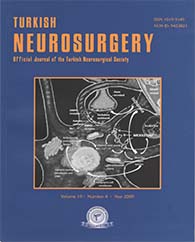Turkish Neurosurgery
2009 , Vol 19 , Num 4
1,3,4I.U. Cerrahpaşa Medical Faculty, Neurosurgery Department, Istanbul, Turkey
2Bone and Joint Disorders Research and Education Hospital, Neurosurgery, Istanbul, Turkey OBJECTIVE: Atlantoaxial stability can be achieved by laminar hook systems via posterior approach. This technique is much more safer than using screws. We presented our experience with the C1-C2 claw procedure.
Corresponding author : Hakan Hanımoglu, drhakanhanimoglu@hotmail.com
2Bone and Joint Disorders Research and Education Hospital, Neurosurgery, Istanbul, Turkey OBJECTIVE: Atlantoaxial stability can be achieved by laminar hook systems via posterior approach. This technique is much more safer than using screws. We presented our experience with the C1-C2 claw procedure.
METHODS and MATERIAL: Seven patients with atlantoaxial instability were operated by using C1 and C2 hooks, rods and transverse connector at Neurosurgery Clinic of Istanbul University Cerrahpasa Medical Faculty between the years 2005 and 2008.
RESULTS: Satisfactory stabilization was achieved in all patients. Operative complication or instrumentation failure was not observed.
CONCLUSIONS: C1-C2 claw is a safe technique and adequate stabilization is achieved with the use of a transverse connector.
Keywords : Atlantoaxial instability, Claw systems, Transverse connector




